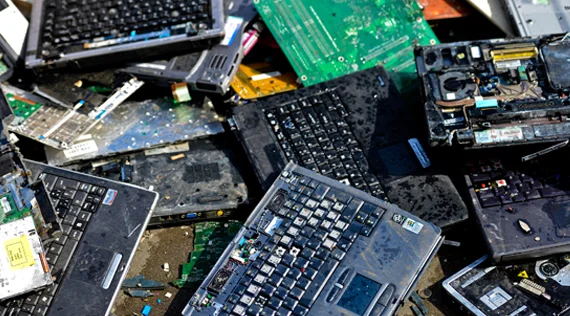
SEATTLE (Scrap Monster): Electronic waste and its associated pollution are becoming increasingly threatening on a global scale. With the continued development of various new application areas including robots, wearable devices, health monitors, and single-use devices, the production of new flexible electronic products is relentless, exacerbating related issues.
Moreover, although the impact of the COVID-19 pandemic on component supply chains such as chips has slowly faded, the fragility of global supply chains is now undeniable. Consequently, more electronic manufacturers are viewing the secondhand recycled components market as a safety net outside of regular supply chains.
In a promising development, engineers from the Massachusetts Institute of Technology (MIT) have partnered with teams from technology giant Meta and the University of Utah to develop a new flexible substrate material. This innovation can be used to produce electronic products with a longer service life. It also boasts advantages such as biodegradability and low manufacturing costs. The material could possibly improve the recyclability of various single-use and wearable device components.
The manufacturing of most flexible electronic substrates incorporates a polymer material called polyimide, also known as Kapton in business transactions. Its advantages include excellent insulation and heat resistance, as well as easily accessible source material, making it clearly beneficial to the manufacturing of electronic products. However, its disadvantages include requiring a high temperature of 200-300℃ during the manufacturing process and being difficult to reprocess and recycle.
In the past, when academic and industry personnel researched the existence of alternative materials, they focused on polymers of opposite types from polyimides that are highly complex. Due to the expensive costs, they are not beneficial to commercialized mass production. Thus, the MIT team directly performed alterations on polyimide material to make it compatible with existing flexible substrate production lines in the industry.
The team used light-curing technology to allow manufacturing of polyimide at room temperature. Additionally, they made molecular-level alterations to the polyimide structure, essentially placing lipids into the polymer chain. Doing so not only avoids affecting the material's flexibility and electrical properties, but when immersed in mild solvents, the lipids dissolve, and the polymer breaks down into small organic molecules, allowing costly components and rare metals to be more easily recyclable.
The issue of disposing of substrates and circuit boards is attracting more attention. Both the academic and business worlds are investing in research with the hope of solving this dilemma. In addition to MIT, a research team from the University of Washington (UW) has made a PCB from a material called vitrimer and named it "vPCB."
Traditional PCBs are fireproof and resistant to chemical corrosion, making them rather durable, and thus, hard to recycle and reuse. However, vitrimer possesses characteristics that allow for reprocessing, chemical recycling, and repairing of scratches, garnering attention for its potential to become a new sustainable material. Not only can this material be solidified to produce PCB, but after expanding it, its components can be retrieved for recycling and reusing.
The vPCB manufacturing process is very similar to that of traditional PCBs, which benefits its promotion to manufacturers. Furthermore, not only can vPCBs be recycled multiple times, but the amount of material wasted during the recycling process is also very low. According to estimates by the research team, within one piece of vPCB, up to 98% of vitrimer material and 100% of fiber-reinforced plastic can be recycled.
Leveraging the technology obtained from its acquisition of Scotland-based company Retronix at the end of 2023, US-based electronic manufacturing service Jabil can safely remove components such as chips from circuit boards received from customers, and reuse them after performing repairs.
These components obtained from recycling are very useful to customers in industries including automotive, telecommunications, health, and national security. This is because the electronic products in these industries often operate in less-than-ideal environments and will be used for decades. If certain components need to be repaired or changed, it may be difficult to find replacements in regular markets.
During the COVID-19 pandemic, there was a severe chip supply shortage, pushing more companies to consider using recycled components, especially customers in industries related to automotive or industrial applications, who were impacted the most by the shortage. Jabil observed that despite the supply shortage being mostly resolved now, market demand for recycling and renovating components is still rapidly growing.
Courtesy: www.digitimes.com



| Copper Scrap View All | |
| Alternator | 0.38 (0) |
| #1 Copper Bare Bright | 4.44 (0.06) |
| Aluminum Scrap View All | |
| 356 Aluminum Wheels (Clean) | 0.79 (0.01) |
| 6061 Extrusions | 0.69 (0.01) |
| Steel Scrap View All | |
| #1 Bundle | 370.00 (0) |
| #1 Busheling | 390.00 (0) |
| Electronics Scrap View All | |